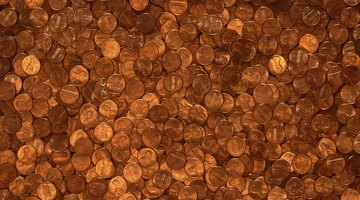DIY: Penny Backsplash
To change the look of your kitchen, replace your backsplash with something that stands out. While kitchen backsplashes are usually made of large or mosaic tiles, you can use anything to make a unique backsplash, including pennies.

Things You Will Need
- Tape measure
- Pennies
- Bucket
- Tarnish remover
- Colander
- Clear mosaic mounting sheets
- Scissors
- Waterproof tile mastic
- Notched trowel
- Metal cutting snips
- Waterproof tile grout
- Rubber tile float
- Damp sponge
- Chamois cloth
- Nontoxic grout sealant
- Brush
Tip
Remove the existing backsplash in your kitchen before starting this project. Use any color of grout, depending on your taste. Remove the electrical outlet covers in the backsplash area before starting the project. Replace them once the backsplash is complete and dry. Substitute washers or other types of coins for pennies. You can also alternate pennies with other coins in your design.
Warning
Wear latex gloves and goggles when handling the waterproof tile grout to prevent irritation to your skin and eyes.
Turn off the power to any electrical outlets in the kitchen backsplash area to prevent accidental electrical shock.
The texture, color and shine of the pennies create a visually interesting backsplash for your kitchen. Use the pennies in random combinations or create designs within the backsplash featuring different shades or sides of the pennies. You can achieve the look you want and save money by completing this project yourself over a weekend.
-
Measure the length and width of the backsplash area to calculate approximately how many pennies you will need to complete your project. The diameter of a penny is approximately 3/4 inch.
-
Place a portion or all of the pennies in a bucket to shine them to a bright, copper finish. Fill the bucket with enough tarnish remover to cover the pennies. Shake it around to distribute it among the pennies. Leave it on long enough to remove the tarnish, according to the directions provided by the manufacturer of the tarnish remover.
-
Pour the pennies into a colander and rinse them with water. If you have not shined all of the pennies, rinse the remaining pennies with water in the colander to remove any debris or dust. Put all of the pennies aside to dry.
-
Cut clear mosaic mounting sheets to fit the size of your backsplash. Keep each sheet to no more than 12-by-12 inches for easy handling.
-
Arrange the pennies on the clear mosaic mounting sheets, face-down on the sticky-side of the sheet. You can arrange the pennies in designs or place them evenly next to each other.
-
Apply waterproof tile mastic to the substrate walls of your backsplash. Use a notched trowel to apply the mastic, holding it at a 45-degree angle. Work in areas no larger than 3-by-3 feet to prevent the mastic from drying too quickly.
-
Press each clear mosaic mounting sheet against the tile mastic, and press the pennies into place with the clear side facing toward you. Allow the mastic to dry completely for several hours or overnight. Remove the clear mosaic mounting sheet from the surface of the pennies.
-
Fill in any spaces along the edges of the backsplash with half-pennies if necessary. Clip the pennies in half with a pair of metal cutting snips. Adhere them in the small places with a small amount of tile mastic applied to the back of each penny. Press on the half-pennies to adhere them to the substrate. Allow the tile mastic to dry.
-
Mix waterproof tile grout in a bucket, according to the manufacturer's directions. Apply a layer of tile grout diagonally across the pennies with a rubber tile float. Hold the rubber tile float at a 45-degree angle during the application.
-
Wipe away excess grout with a damp sponge when the grout becomes firm after about 30 minutes. Allow the grout to dry completely.
-
Wipe the pennies with a damp sponge again. Shine the pennies with a clean chamois cloth. Once they are dry, paint the backsplash with a nontoxic grout sealant. Allow the backsplash to dry.
References
Writer Bio
Susan Paretts loves to tackle home improvement projects and has contributed to a variety of publications regarding home repair and home decor, including eHow, SFGate, Hunker, Apartment Therapy and House Beautiful among others. Her expertise is in home repair, home decor, home staging and DIY.
Photo Credits
- Jupiterimages/Photos.com/Getty Images
- Jupiterimages/Photos.com/Getty Images
More Articles



